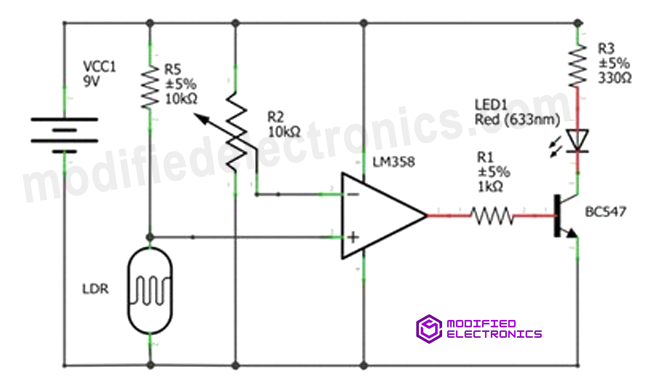Introduction:
In this project, we will be creating a Emergency light using LM358 and LDR sensor that senses darkness. Unlike a light detector circuit, which detects light, this sensor will be used to indicate darkness. We will be using a comparator circuit with the LM358 IC, which has two inputs and one output. By manipulating the sensitivity of the circuit, we can adjust the darkness level at which the emergency light will turn on.
Hardware Required:
| 1 | × | LM358 IC |
| 1 | x | Transistor T1 BC547 |
| 1 | x | LED |
| 1 | × | LDR sensor |
| 1 | × | 10 KΩ Potentiometer |
| 1 | × | 10 KΩ Resistor |
| 1 | 330 Ω Resistor | |
| 1 | × | 220 Ω Resistor |
| 1 | × | 9V Battery with Cap |
Emergency Light Using LM358
In this project, we will be using the LM358 IC to create an Emergency light using LM358 and LDR sensor. The LM358 is a dual operational amplifier with low power consumption and high gain. We will be using one side of the IC for our single-side sensing task.
The LM358 IC has three pins available for each operational amplifier: the non-inverting terminal (PIN 2), the inverting terminal (PIN 3), and the output (PIN 1). When the voltage at the non-inverting terminal is higher than the voltage at the inverting terminal, the output goes high, providing a voltage output as a signal.
Circuit Diagram:

Working:
In the circuit, we have connected the LDR (Light Dependent Resistor) to PIN 2, which is the inverting terminal. When light hits the LDR sensor, the resistance through its pins decreases, resulting in a higher voltage supply at PIN 2. This leads to a low output at PIN 1.
To create a variable sensing device, we add a variable resistor at PIN 3. By adjusting the resistance, we can manipulate the sensitivity or set the value of darkness to be sensed. When the variable resistor is set to low resistance, the voltage at PIN 3 increases. This requires a lower input signal at the inverting terminal (PIN 2) to stay below the voltage at PIN 3, resulting in a higher output. As the resistance is increased, the sensitivity of the sensor increases, as it requires less voltage at PIN 3.
Application:
The Emergency light using LM358 and LDR sensor has various applications, including:
- Automatic bike headlights
- Dark detection lights
- Automatic car headlights
- Home emergency lights
- Street lights
These applications make use of the circuit’s ability to detect darkness and automatically turn on lights when needed. Whether it’s for safety purposes or energy efficiency, the emergency light using the LM358 and LDR sensor provides a reliable solution.
Conclusion
the emergency light using the LM358 and LDR sensor is a simple yet effective circuit that can be used in various applications. By understanding the working principle and adjusting the sensitivity, users can customize the circuit to their specific needs. Whether it’s for automatic headlights or emergency lighting, this circuit offers a practical solution for detecting darkness and providing illumination when required.